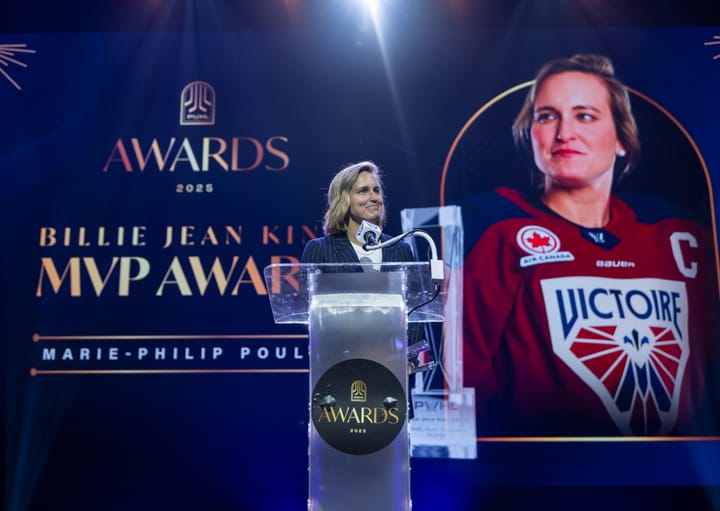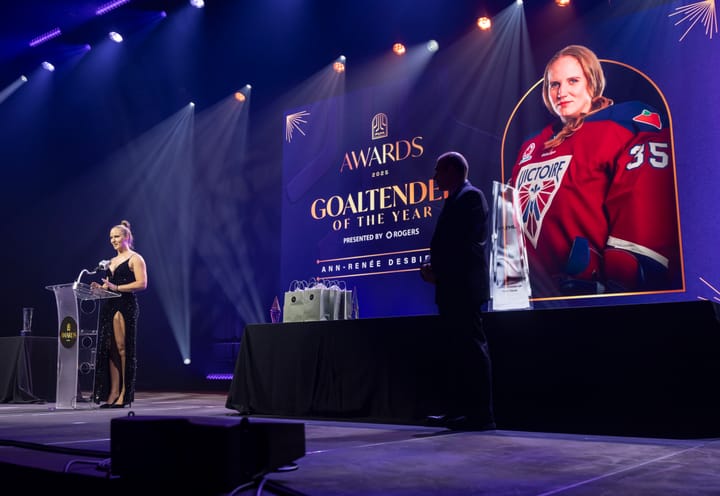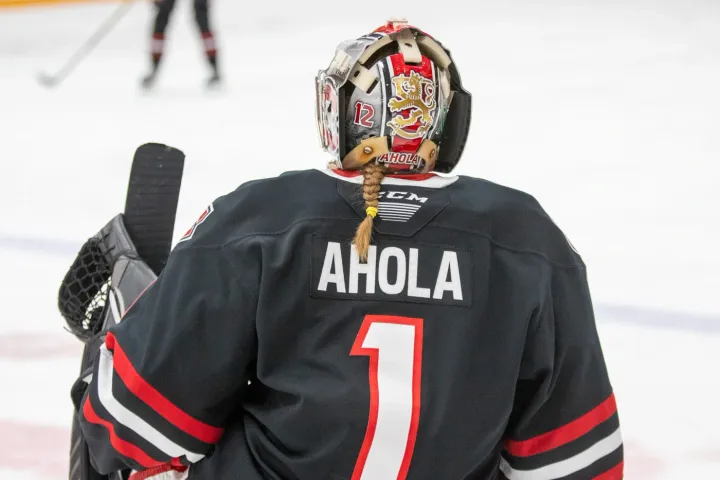The $1.5 million future and what comes next for pro women’s hockey
The pro hockey lifestyle is arriving
The hockey world is still abuzz over the PHF doubling its salary cap to $1.5 million in 2023-24. To be clear, there are still major questions that need answers, including where the money coming from and if the cap stays at $1.5 million in 2024-25 and beyond. We all want to know if this is sustainable and if this is familiar investors pushing more of their chips to the center of the table in a gambit to make the PHF the destination for all of the world’s top talent — including those players who are currently in the PWHPA. Sooner or later, more details will emerge to erase some of the question marks attached to that $1.5 million.
Let’s talk about that number. A $1.5 million salary cap represents a lot of things to a lot of people. One thing it represents is bringing more athletes closer to something that only a precious few have experienced — a true pro lifestyle in women’s hockey.
It means more players looking to their hockey careers as a true primary source of income, We will have more full-time pro women’s hockey players in 2023-24 than ever before and the game itself will be better for it. Even with all of the questions that still require answers, that’s an exciting future to think about.
Related
PHF Salary Cap Reaches New High: Will Double to $1.5 Million for 2023-2024 Season
This season, most PHF teams signed 21 of a possible 25 players to their rosters. Let’s assume teams will look to add another body with more money to work with and assume that teams, on average, will have 22 players signed. That $1.5 million divided evenly among 22 players — for example, 12 forwards, 7 defenders, and 3 goalies — is an average of $68,181 for each player. For a 23-player roster, it’s $65,217. For 25 — the current maximum roster size — that average is $60,000 if a team spends to the ceiling (that’s a big “if”). That should be a living wage in any of the PHF’s seven markets, especially for six months of work.
Of course, that doesn’t mean every player will make $68,000 or $60,000 next season. We won’t know what the average salary will be or what the salary range for most PHF players will be until we have full salary transparency. The question that grips me the most here is just that — what will most players make? I don’t want to know the mean. I want to know the mode. How much money will those who will be making the least see on their checks? How many players will still find themselves on the outside looking in on the pro lifestyle?
This is something that players, including those who have been in the league since day one, are already thinking and talking about.
“I think the hardest part is getting everyone on board,” Riveters captain and original NWHLer Madison Packer told The Ice Garden. “We don’t need to start paying players $150k, $130k. Maybe there will be a couple around the league making $100k but as a player that’s been there since the beginning, it’s getting everyone to see the bigger picture that we want everyone to get paid a little bit more. We don’t need a couple of players to get paid a ton. That’s what’s best for the game and what’s best for the future of the league. That is what will get everyone to come to one spot.”
We know that the salary cap is doubling, but we don’t know what the new league minimum will be. In many ways, that is the most important number in this equation.
Under the $750,000 cap, the minimum is $13,500 — a far cry from a living wage. If the minimum doubles wih the cap, we’re at $27,000 — that’s not enough to live off of. For context, 16 of the reported and disclosed salaries this season have an AAV of $40,000. While it’s true that the season only covers half a year it’s also true that a pro career playing on Friday nights and weekends with multiple practices during the week is not compatible with many off-ice careers. This lifestyle isn’t accessible to everyone right now, including some of the top players in the world.
Looking at historical contract data compiled for Cap Besties, the highest reported salary and therefore cap percentage belongs to Mikyla Grant-Mentis, who is making an estimated $80,000 per Jeff Marek. That contract represents about 10.67% of the Beauts’ salary cap. That same cap percentage would be in the neighborhood of $160,000 under next year’s $1.5 million salary cap. Alex Azzi also reported that Kali Flanagan of the Boston Pride was making at least as much as Grant-Mentis.
One has to wonder how many star players can expect to make six figures in 2023-24 and what that means for all those who skate outside of the spotlight of national teams and All-Star game appearances. What kind of money will everyone else — on and off the ice — be making?
“If you get the minimum to $30k or $35k college kids will say, ‘Oh, I can go play hockey for a guaranteed $35k for six months?’” Packer shared. “That just didn’t exist before ... I think the next step after that will be getting staff paid better, which doesn’t come out of the $1.5 million, but we need everyone across the league to make more money.”
Getting the league minimum closer to a living wage in the PHF’s markets creates a different world not just for players, but for everyone. It gives players a choice to pursue hockey full-time, to look at hockey as a true career choice and not just a passion that can help pay some of the bills. The same question of making a living wage is also true for staff. Those who follow the PHF closely know all too well that there is turnover on and off the ice every year. How much better does the quality of the product become when everyone can look at hockey as a career and not just a job?
A thought. Next offseason, a PHF GM could establish an internal minimum salary of $50k for a 23-player roster in 2022-23 and still have $350k to work with to pursue key targets in free agency and/or to distribute in tiers of compensation.
— Mike Murphy (@DigDeepBSB) December 31, 2022
13 forwards
7 defenders
3 goalies
The most exciting aspect of the pro lifestyle becoming more commonplace in the PHF is that it presents more incentive and opportunity for players to invest in themselves as players. When hockey is your main gig, you can put more time and energy into it. We will see players develop more and benefit more from resources like skills coaches and more frequent practices.
The players will get better, the league will get better, and the sport and all those who love it and support it will benefit.
“I won’t single people out, but look at the U.S. national roster right now — there are names on that list that wouldn’t be there without the NWHL and you’re going to have more of that,” Packer said. “The Riveters have the closest to a men’s model of any of the teams. We practice four days a week, we have a skills coach, a goalie coach, and ice every morning here for two hours. That’s what we’re [all] transitioning to. Look at [Loren] Gabel and [Élizabeth] Giguère — Boston’s a great team — you get those players on the ice in a team environment with puck touches more consistently and those players are going to continue to develop.”
“We want everyone to get paid a little bit more. We don’t need a couple of players to get paid a ton.” - Packer
Packer noted that the pro lifestyle also includes opportunities for endorsement deals that maybe weren’t as present as they were a few years ago. She shared that she makes approximately 40 percent of her hockey income from sources outside of her salary. While endorsement opportunities might not be available for every player, they will be there for some. And that is something that high-profile players could be considering when they are negotiating their deals in the offseason.
Of course, it goes without saying that we all want players to make as much as they can. They deserve that. But we should also acknowledge that everyone will benefit when those who make the least in the league make enough to experience a true pro lifestyle. That is something that could be very present in PA discussions over the next few months.
The path to where we are today and where we will be tomorrow has been unforgettable. The road isn’t finished, but it feels like we’re at a major landmark with next year’s salary cap being doubled and the PWHPA full steam ahead to create a league of its own. We all want to know what happens next but in order to understand it all we need to remember where this road started.
“When I joined the league originally, I thought this was going to be it,” Whale captain and original NWHLer Shannon Turner told The Ice Garden. “I was all-in with Dani Rylan [Kearney] starting the league and I saw her vision and thought, ‘This is awesome, this is going to be it.’ Back then, all the top players were in year one like Kacey Bellamy, Meghan Duggan, Molly Engstrom, and Kelli Stack — everyone was buying in that first year. But that’s the way some things go. You try things out year one and if it doesn’t go perfectly you look for the next best option.”
The PHF of today is different in much more than just name for veterans like Turner and Packer. Players have more resources than ever before. We see team logos on ice surfaces in some rinks, games are streamed on ESPN+, there’s more international talent in the league, and there are more sponsors than ever before. Packer believes this league isn’t going anywhere. Turner is right there with her.
“I’m of the mindset that anything that is worth doing is not easy, otherwise everyone would be doing it,” Turner continued. “You’ve got to invest time. We took steps backward but we have obviously also taken some huge leaps forward. I’m super excited for all the girls. Like Tori Howran signing for two years — they’re all coming back next year and they’re going to get to enjoy it. It’s awesome to think about that. Caitrin [Lonergan] — this makes me feel really old — but she said, ‘I watched you as a senior in high school and you were in the league.’ Dear lord.”
Right now, the 2023 IIHF U18 World Championship is underway in Sweden. In just a few short years, some of the players representing the future of women’s hockey could be stepping onto PHF ice as rookies. One of them might even be in the same locker room as Caitrin Lonergan and will get to make her feel old by sharing that they watched her play with the Whale on ESPN+. If things continue to trend the way they have been, those players could be joining a league — or leagues — where everyone on and off the ice has the choice to pursue hockey a full-time job.
So, how soon do we get there? It might be sooner than you think depending on what happens with the number $1.5 million.
Salary information from CapBesties.com | Disclosure: the author of this story is a co-creator of Cap Besties.





Comments ()